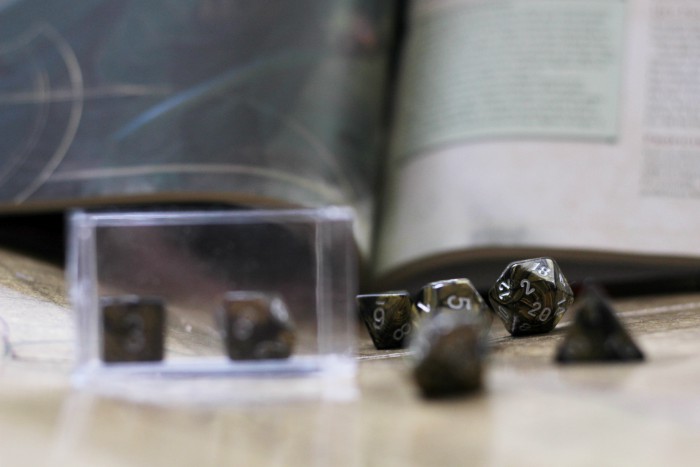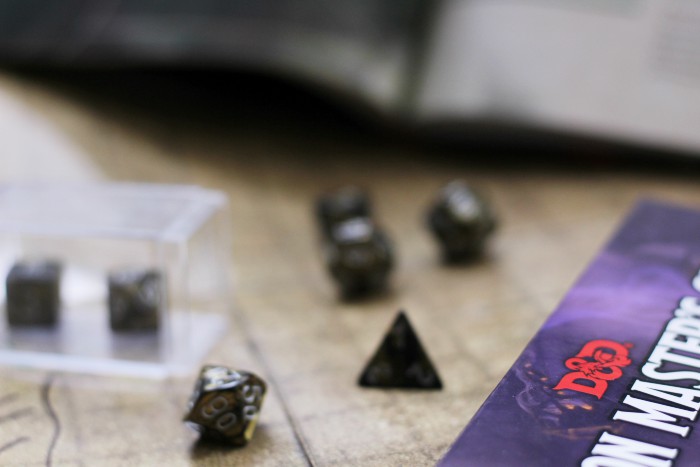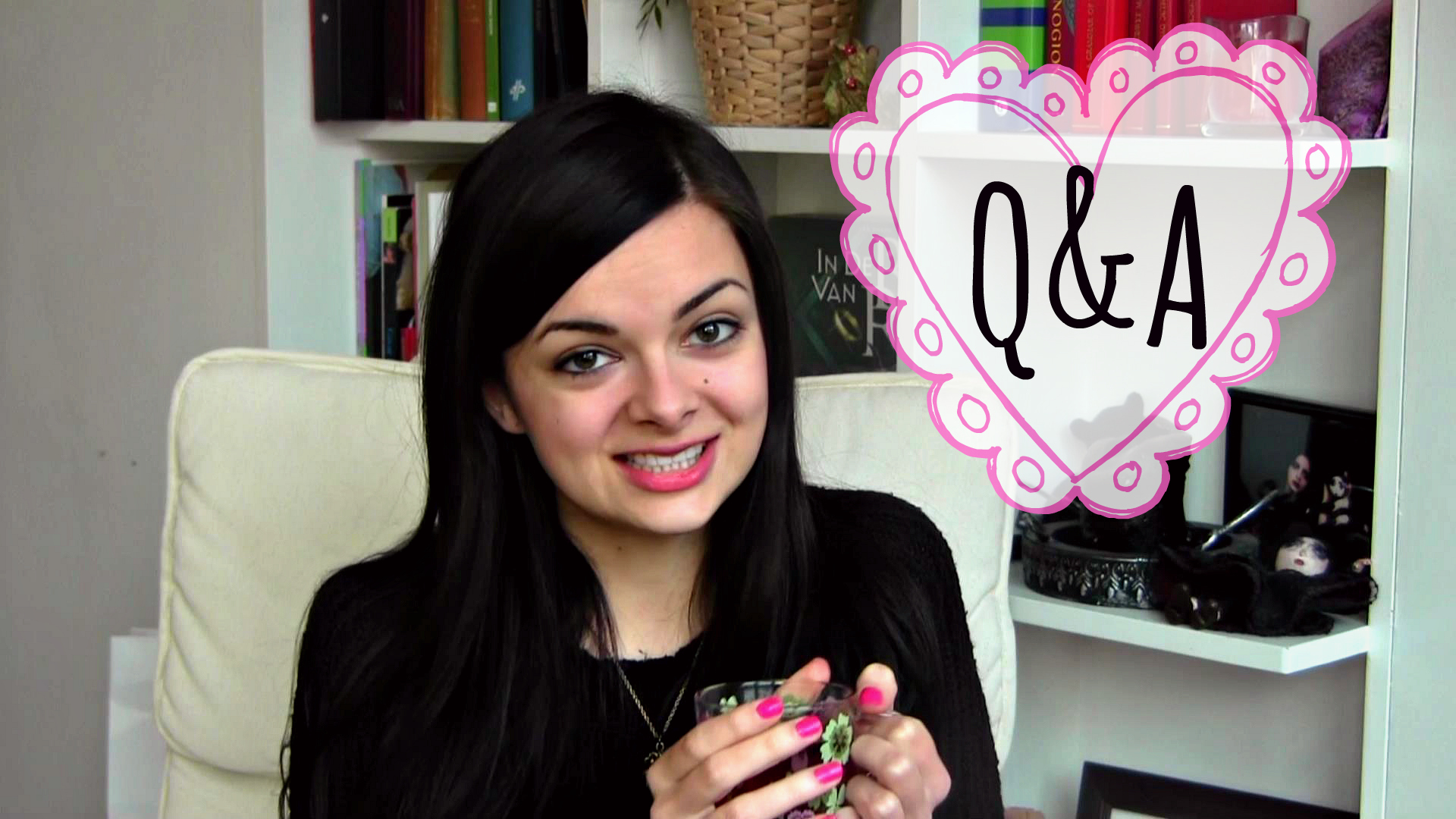Every now and then I mention Dungeons & Dragons in passing on my social media, and usually that mention is met with enthousiastic DMs from fellow players and questions from people who’ve never heard of it before. Today I wanted to talk about this classic nerdy game; briefly explain how it works, what my own experience is with it, and also answer a few questions I received through Instagram.
What Is D&D?
Dungeons & Dragons is a tabletop roleplaying game, generally set in a fantasy world. I always describe the experience of playing as somewhere between reading a book and playing a video game. There is a Dungeon Master, that’s the person who leads the game. This DM builds the world that the game takes place in, and guides the players through it. The players each have their own character who moves through the DM’s world and interacts with it.
Usually there are very few visuals involved in the game: the DM will explain how the world looks, works and reacts in words. A large part of the game revolves around interactive storytelling. The game itself can be played on a gridded playing field, which the DM can draw maps or blueprints of buildings on, or otherwise sketch visual aids to explain the situation the players are in. That’s not necessary, though.

How Does It Work?
So you have your DM, who leads the game, and a small to medium-sized group of players. Each player moves through the game with their character, which they design themselves. Everything you know about your character determines how it behaves, how strong it is, what skills it has, what items it owns etc. Each character should have at least a rough outline of their background and/or past. Now here begins the more technical part of the game.
Each player has a character sheet, a piece of paper where they can keep track of their character’s statistics, skills and items, among other things. Your statistics are based on the character’s background, race, class, and level, and they determine how you perform within the game. Are you strong and fast enough to slash a certain enemy with your sword, or survive being hit by them? Are you nimble enough to slip through a narrow window? Are you smart enough to spot the trap in front of you?
There’s a player’s handbook which explains all of these mechanics and gives you the numbers you need for the type of character you choose.
Your statistics are nearly always used in conjunction with a die roll; and that’s where those funny-looking multi faceted dice come into play. Even the strongest character can fail to push a boulder aside, if they roll a low number. An unintelligent character could still figure out the answer to a riddle if they roll an extraordinarily high number. The number you rolled combined with your own statistics determines the outcome of any action you wish to take within the game.
In-game fights have their own separate mechanism within D&D. Each character has a set of attacks they master, and weapons they use for those attacks. They also have a number of hit points. Dice are rolled to determine whether you hit a foe and how much damage you do them. Fights are conducted in rounds, with each party involved getting to move once per round, so all characters, non-playable characters and monsters/enemies (all controlled by the DM) take a turn. There is a limited number of actions you can take within your turn. Usually you’d move towards or away from an enemy and attack, for example.
When you’re hit, you lose hit points. Losing half your hit points leaves you bloodied, and coming down to 0 makes you lose consciousness and have to be protected/healed by the rest of the party. If you keep losing hit points after this point and reach the negative of your maximum hit points, the character dies. Enemies and monsters generally die straight away when reaching 0 hit points (fun thing is you won’t know when that’s coming, as the DM probably won’t tell you :) )
The game is a bit complicated at first and requires a lot of preparation in worldbuilding and character building, but once you start playing everything makes sense and is worth it. I promise.
My Campaigns & Characters
I first got invited to play when I was in university, by a classmate whose then-girlfriend was (is) a good friend of mine. He had DMed before and was looking for people to start a new campaign with, and she thought I might enjoy it. A beautiful hand-writted letter easily convinced me to join, and that’s how it all started. The group consisted mostly of first time players so we spent an entire session just learning to understand the rules. We played D&D 4th edition at the time, which is a bit more complicated than the newer 5th edition rules.
The campaign was a homebrew, set in a fantasy world where Norse mythology is real. It’s a crossover between the classic, basic D&D world and the world of Norse gods, Yggdrasil and the ever present threat of ice giants destroying the world.
My character in this first campaign is a bit of a mess, as I didn’t really know what I was doing when I built her, but she’s also my ultimate favourite character ever. Her name is Bíta, she’s a longtooth shifter warlock, whose entire life was wiped away when goblins torched her village and killed her family. Now she’s out for vengeance. She’s a chaotic evil character, and her storyline is pretty much played out at this point in the campaign. You see, we never stopped playing and this campaign has been going on for six years :) I still love her, though, and this is till my favourite campaign to play.
Over the years some people left the group and others joined, and at a certain point the group consisted of only Celtic students and Robbert. One of the other players wanted to try her hand at DMing as well, so we started a new campaign.
The second campaign is also set in a fantasy world, but very different from the first one. This world exists after a long period of war between the different races. A peace-keeping community was founded on an island at the center of the world, where all races meet to talk and work out any problems. As the human race keeps growing quickly and starts expanding their territory for need of more land to grow food on, tensions begin. A new religion rises in the South of the human lands, lead by a group of priests who promise salvation to the impoverished and famished human race. Needless to say, they have ulterior motives.
My character in this campaign is Tashan, a young, idealistic dragonborn fighter who works for the peacekeeping faction. She’s dissatisfied with the way the impeding chaos is handled on the island, and decides to join a group of envoys who travel to the human lands to see what’s really going on. Her alignment is lawful good. I believe we’ve been playing this campaign for four years now.
Robbert’s best friend joined our group, and our original DM started a new campaign, very different from what we had done before. It’s a pirate campaign, very low magic. All characters are human, and the magical classes don’t exist. The story is set at sea, where an unlikely group of strangers meets on a trading ship on its way to the new world. They run into trouble pretty early on and find refuge on the most powerful pirate island in the area, where they forge alliances with the pirate lords.
My character in this campaign is Mei Ling, a human rogue refugee from the largerst power in the world, the Empire. She’s an alchemist who always loved pushing the boundaries of the natural and possible. Once she started dabbling in the very secret, mysterious and highly forbidden art of magic, she was persecuted. She managed to get away from the mainland and find employment as gunpowder master on a trading ship. Her goal is to investigate and find the mythical “living ship” that’s been rumoured to roam the seas by the new world. Mei Ling is true neutral. This campaign has been running for two years, if I’m not mistaken.
Robbert wanted to try his hand at DMing as well, and thus begins our fourth running campaign. A few more people are joining the group for this campaign, and we’re only just starting. We had an introductory session and the first proper one will be held this Sunday.
This campaign is set in a world inspired by the world in Avatar: the last airbender. I don’t know much about it yet, but it’s divided into nations based on the element bending skills of the inhabitants. The campaign begins in a period inbetween Avatars, when the threat of the world falling out of balance is very real.
I’m hoping none of the other players read this as they don’t know anything about my character yet, but my character is called Mots’eva and she’s a smoke specialist fire bender off the remote and secluded smoke island. She’s specialised in producing poisonous and psychoactive smoke and yeah, she makes money that way ;) She’s chaotic neutral and barely speaks any conventional language, so that’s bound to be interesting. She enters the game on a mission to expand her trade.

Q&A
I put one of those question stickers out on my Instagram stories and you guys sent me a bunch of questions, so let’s go through the ones that haven’t been answered above yet.
How does your interest in hair and clothing affect how you design your D&D characters?
It barely does, aside from me maybe knowing what my character wears and how they do their hair in a bit more detail than other players. Although, thinking about it, nearly all of my characters have stolen fancy clothes somewhere at some point, hahaha!
How did you find people to play with?
When we first started playing we mostly tapped into a pool of people who already had similar interests to begin with, namely our fellow students of Celtic Studies. It wasn’t hard to find potential players there. Later on when we graduated and people left, we engaged the rest of our social circle. Right now our biggest party consists of two of my former classmates, my boyfriend, his best friend, a friend from our scouting group, and my brother. Everybody knows Robbert and I play D&D, and it tends to spark an interest with some :)
I personally really like forming a group of people I already know, so that I’m sure everybody will get along well. I’m not sure I’d start playing with an existing group, or a group of strangers, although I do know some people do that and it can definitely go well.
How long does a game last?
Infinitely!!! No seriously, for however long the DM and players want it to. It’s up to you to either finish/play out a campaign or keep finding new quests and drag it out forever. We’re quite attached to our campaigns and we play very slowly and in much detail, so our campaigns can easily go on for many more years, but they don’t have to.
As for individual playing sessions, we usually play for around three hours at a time.
How often do you guys meet and how do you find the time?
We have a set evening in the week when we meet. We have dinner together and then we play, take a snack break, and play again. Our DM moved abroad to get his PhD so we’ve been playing digitally for the past few years. All players who are in the same country meet up in person, and we ring in the other person through Roll20. Whenever he’s back home we all meet in real life.
We only play the first, original campaign when we’re all together, so that’s a few times a year. The other three campaigns we alternate between. Every month we play each campaign once, and take a break in the fourth week.
As for finding the time, I find that when a session is scheduled in, it’s scheduled in. We play in the evenings and I would normally spend that time just vegging out and watching Netflix, so in my mind it is much better spent this way.
How do I get started when me and my friends don’t know anyone to explain it to us?
When you want to start playing you’ll need two books: the player’s handbook and the dungeon master’s guide. When you read through both (the players only read the player’s handbook), you’ll know everything there is to know and be ready to begin your campaign, even when you’re all first time players.
Do you like to play characters that share your own personality or someone really different?
I’ve found that I enjoy playing most when a character is an extension of myself, or could be a version of myself in different circumstances. I tried playing a middle aged holy man once and just couldn’t do it; I dropped that character and made a new one. I like playing intuitively and that only works when the character is really secretly just me with less boundaries ;)
Do you do voices for your characters?
I personally don’t, but some of the other players in my group do and I love it.
When it comes to character creation, do you write detailed backstories, or keep it vague?
I prefer to have a simple backstory that explains a few things about the character, but nothing too complicated. A very detailed backstory can become a problem during playing when it clashes with the backstories of others, of when the character has a strong pull towards something that isn’t shared by the group. I like to keep things basic so that my character can kind of go with the flow. I also like slightly adjusting my characters to better fit the group they’re in, and that only works when everything isn’t set in stone.
What types of stories do you like to play? Do you enjoy more fights or quests?
I definitely enjoy the storyline aspect of the game more than the fights. I’m bad with numbers so counting the rolls and stats all the time can stress me out a bit, and I usually just don’t find that part of the game very interesting. I love moving through the world, talking to NPC’s, and playing out quests.
Any tips for keeping the game moving and not getting stuck debating what to do?
My group has spent over half a session debating what to do on more than one occassion. Our first campaign has been going on for seven years and only a few months have passed in-game. Honestly, I don’t think I’m the one to give a solution to that! Although I do think debating is part of the fun, when it takes too long it’s up to the DM to speed it along by introducing the sound of footsteps growing nearer in the distance, for example ;)
Do you have any theories/ideas about what your alignment would be in real life?
Hahaha, love this question! I’m lawful to the extreme, and self-centered enough to be considered neutral, I think. I’m gonna go for lawful neutral.
Whoa, this post turned out to be much longer than anticipated. I hope you enjoyed reading it, and would love to hear about your experiences with D&D in the comments below!







Great post, thank you Lucy! Glad you answered my question :) I am starting a new DnD group next week, I’m quite curious to see how it goes. Until now I have only played a popular German role playing game, that’s also fantasy, and I’m really excited to find out how different rule structures affect the game play. Have you ever played another ruleset apart from DnD?
D&D is the only roleplaying game I’ve played so far. Good luck with your campaign! :D
Das schwarze Auge? How was it?
A new group of DnDers who don’t have people around to explain things may find helpful resources on YouTube. :) Also I’m glad you mentioned that it’s possible to play the game without magic; many people that I know are uncomfortable with the idea of DnD because of the magic content, but the game can be tailored to the taste of the DM/players.
I play a chaotic good halfling rogue in our regular campaign and a neutral good human storm sorceress in the “marches” style game we play. The sorceress has hair that grows really fast, so she gives herself a pixie cut every morning, and it’s floor length by night. She wakes up in a nest of hair. ;)
DnD is a teamwork-oriented game. The characters might not necessarily get along (that can add fun drama to the party dynamic), but a game goes best if your goal is to make the game a good experience for everyone else (including the DM!). :D
I’m so glad you talked about DnD! I’ve been hoping you would for… a long time, lol. I’ve wanted to meet your characters and hear about your campaigns!